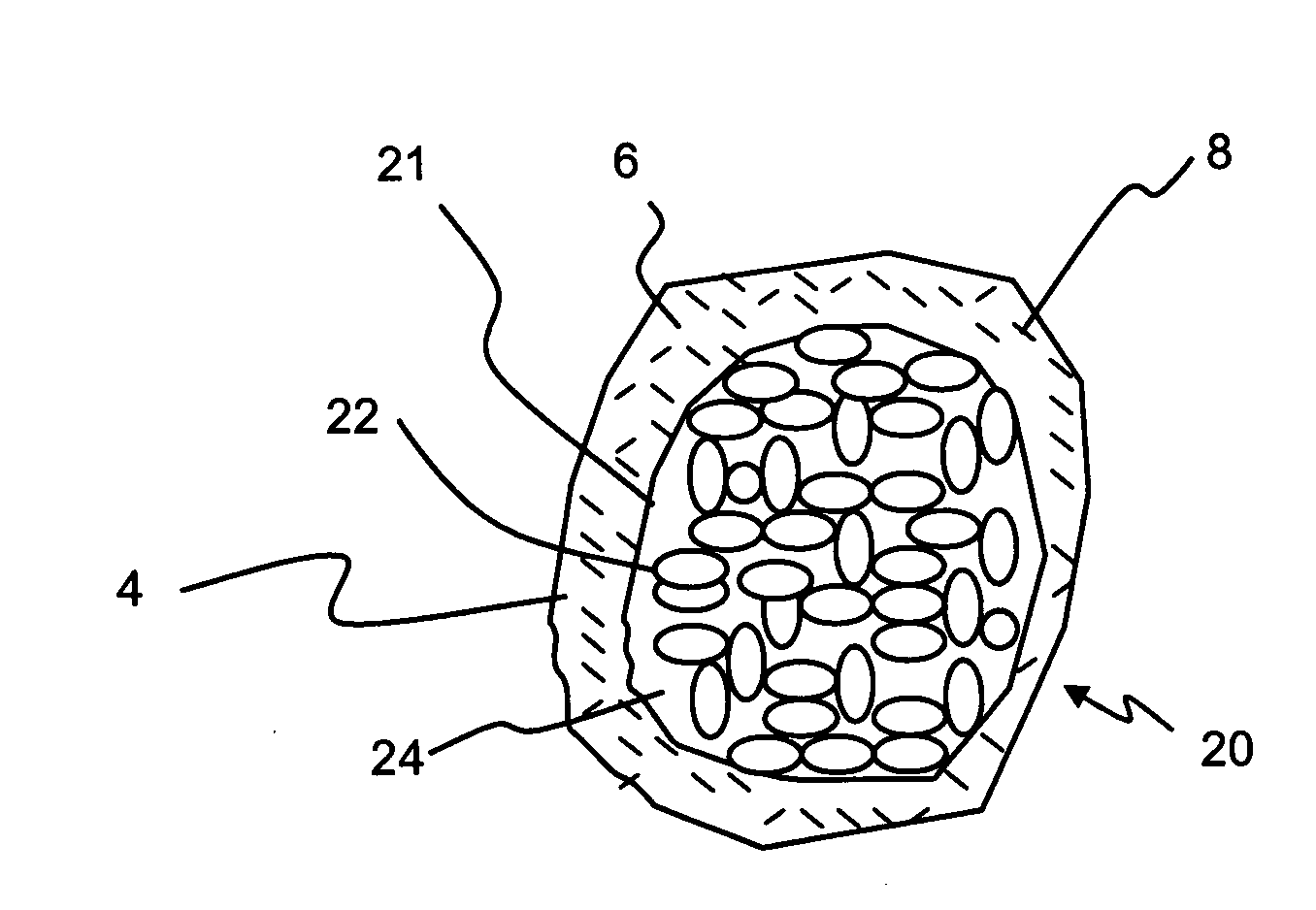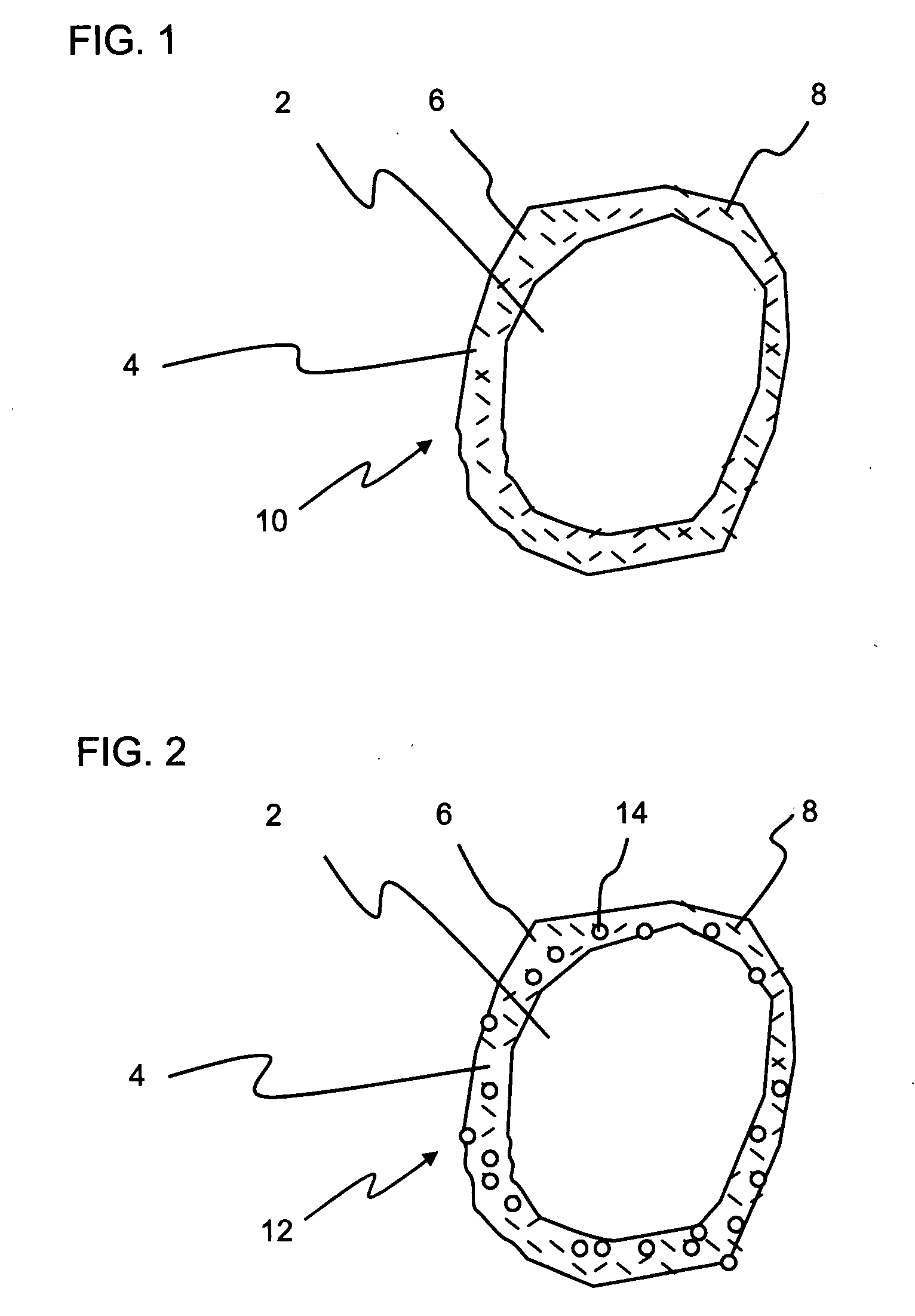Low temperature coated particles for use as proppants or in gravel packs, methods for making and using the same
a technology of coating particles and proppants, applied in the field of coating particles, can solve the problems of high energy cost, low flow capacity of sintered ceramic particles, low strength, etc., and achieve the effects of low capital cost, quick and economical expansion of production capacity, and low crush valu
- Summary
- Abstract
- Description
- Claims
- Application Information
AI Technical Summary
Benefits of technology
Problems solved by technology
Method used
Image
Examples
example 1
[0231]This experiment was conducted to determine the properties of a coated particle of the present invention. The coating cycle was as follows. 1000 grams of CARBOPROP® 12 / 18 intermediate density ceramic particles at room temperature were added to a Hobart lab mixer. Then the mixer agitator was started. Then 0.8 grams of A1100 (aminopropyltriethoxysilane) was added and the timer is started, (0:00 minutes). After 30 seconds, 10.0 gms of EX262E (phenol-formaldehyde liquid resole) was added. When the timer is at 2 minutes, 18.4 grams of SD909A phenol-formaldehyde novolak powder (with 15% hexamethylenetetramine) was added with continued mixing (about 2.4% total organics on the particles). When the timer is at 12 minutes, the mass was free flowing and was removed from the mixer. This product was then tested for 24 hour UCS bond strength at conditions of 1000 psi and 200° F., yielding 590 psi.
example 2
[0232]This experiment was conducted to determine the properties of a coated particle of the present invention. The coating cycle was as follows. 1000 grams of CARBOPROP 12 / 18 intermediate density ceramic particles at room temperature were added to a Hobart lab mixer. Then the mixer agitator was started. Then 0.8 grams of A1100 (aminopropyltriethoxysilane) was added and the timer is started, (0 minutes). After about 30 seconds, 10.0 gms of EX262E (phenol-formaldehyde liquid resole) was added. When the timer is at 2 minutes, 33.2 grams of SD672D powder (phenol-formaldehyde novolak, no hexamethylenetetramine) was added with continued mixing (about 4% total organics on the particles); SD672D powder had a particle size of particle size of + / −100 mesh. When the timer was at 12 minutes, the mass was free flowing and was removed from the mixer. This product was then tested for 24 hour UCS bond strength at conditions of 1000 psi and 200° F., yielding 1075 psi.
example 3
[0233]A curable resin coating was developed by adding 0.4 grams of coupling agent (A-1100 silane) to 1 kilogram of substrate with constant agitation. A liquid resole (OWR-262E), available from Hexion Specialty Chemicals, Inc., Louisville, Ky.), was added at 15 seconds into the cycle, after the silane. A powdered novolak resin FD900-A, (with 7% hexamethylenetetramine was used to prepare Samples C, D and G), or a powdered novolak resin, SD-909A, (with 15% hexamethylenetetramine was used to prepare Samples A, B, E, and F) each available from Hexion Specialty Chemicals, Inc., Louisville, Ky. was then added at 1 minute into the cycle time. The material was mixed for 4 additional minutes and discharged from the mixing apparatus. Using the procedure above, analytical properties varied while evaluating alternative resins, resin levels, particle sizes and substrates. Concentration of hexamethylenetetramine in the novolak powder thus varied from 7-15%, dependant upon which powder was used in ...
PUM
| Property | Measurement | Unit |
|---|---|---|
| particle size | aaaaa | aaaaa |
| acid solubility | aaaaa | aaaaa |
| density | aaaaa | aaaaa |
Abstract
Description
Claims
Application Information
 Login to View More
Login to View More - R&D
- Intellectual Property
- Life Sciences
- Materials
- Tech Scout
- Unparalleled Data Quality
- Higher Quality Content
- 60% Fewer Hallucinations
Browse by: Latest US Patents, China's latest patents, Technical Efficacy Thesaurus, Application Domain, Technology Topic, Popular Technical Reports.
© 2025 PatSnap. All rights reserved.Legal|Privacy policy|Modern Slavery Act Transparency Statement|Sitemap|About US| Contact US: help@patsnap.com



